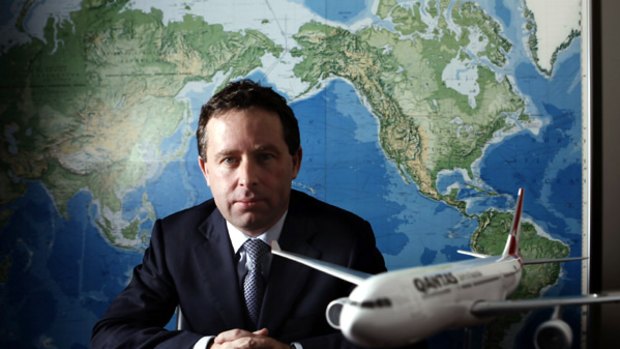
Plane sight ... Alan Joyce says the Qantas network will not be "Jetstarised".Credit: Louise Kennerley
The low-cost carrier will no longer be used to replace Qantas flights, writes Clive Dorman.
Qantas will go head-to-head on the London route against low-cost carrier Air Asia X without a competitive response from its own low-cost subsidiary, Jetstar.
And there are doubts over plans by Jetstar to eventually provide a low-cost service to the US to complement the Qantas full-service offering.
In an interview leading up to last week's Qantas annual meeting, chief executive Alan Joyce moved to allay fears among the company's 35,000 employees that the national carrier would continue to be "Jetstarised" to further lower costs as the group faces unprecedented price competition on its key international routes.
Those fears were heightened recently when Jetstar began up to five return flights a day between Sydney and Melbourne's Tullamarine airport in competition with Qantas's high-frequency CityFlyer service to meet a competitive challenge by Tiger Airways.
"We have decided that, with Qantas, we have gone to a minimum network, a network we can't drop below," Joyce was reported as saying. "There will be no further replacement of Qantas flights with Jetstar – that's it."
Joyce has ruled out Jetstar flights to London in competition with Malaysia's Air Asia X, which was offering fares as low as $1100 return from Australia to London's low-cost Stansted airport at the bottom of the recent international air fares collapse.
Joyce, formerly Jetstar's founding chief executive, has restated Qantas's original intention to send Jetstar to Europe – but only to reclaim markets that Qantas had previously abandoned because of its comparatively high costs.
In the 1980s and 1990s, Qantas axed flights to Athens and Rome, despite high average loads, because both destinations mainly served visiting-friends-and-relatives markets and did not attract the business travellers necessary to make a profit.
While Jetstar has been used to establish new international leisure markets for Australians, it has also been used, for example, to replace marginal Qantas services from Melbourne and Sydney to Bali and big loss-makers from Cairns to Japan.
Joyce says the Japanese routes stood to lose as much as $100 million a year and would have been abandoned by the Qantas group had it not been for Jetstar. The subsidiary has also been used to replace Qantas domestic services in New Zealand, turning a loser into a break-even proposition.
Meanwhile, however, Qantas will pit its own full-service offering against Air Asia on the kangaroo route, even though Air Asia is nominally hundreds of dollars cheaper.
However, so-called ancillary charges on long-haul low-cost services – for everything from food to luggage, blankets and preferential seating – can narrow the gap to just a few dollars.
Looking a month ahead, Qantas last week was asking more than $2200 for a return seat to London from Melbourne or Sydney, dearer even than its key competitor Singapore Airlines.
However, between Australia and the US, fares are even more volatile because of fierce competition, even without the low-cost element.
A month out, Qantas is shooting for nearly 50 per cent more than the cheapest rates in the market – its best fare about $1460 return compared to $1051 on United Airlines – using the popularity of its Airbus A380 super-jumbo to extract a premium.
Sign up for the Traveller Deals newsletter
Get exclusive travel deals delivered straight to your inbox. Sign up now.